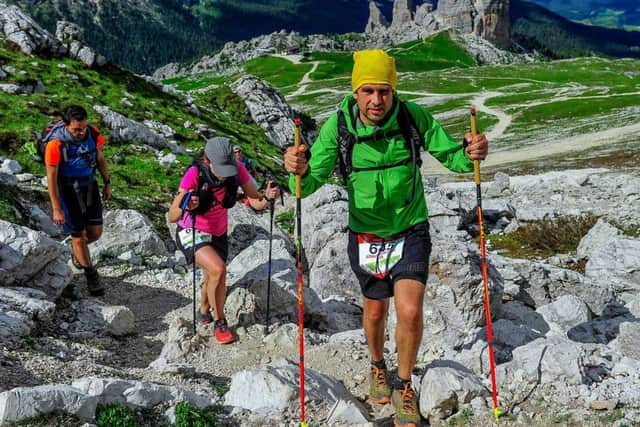Ultra marathon runner tells of being pushed to limit


“You run triathlons, don’t you?” he asked.
“No,” I replied.
“Oh. Ultra marathons?”


“No,” I said. He looked confused.
“Just marathons?” he said.
It had taken me years of running to finally take on the marathon, and by then I had done six and felt pretty pleased with myself. But after this encounter at the tea point I realised that running a marathon was no longer that impressive. Everyone was running marathons. We had reached a point in the natural inflation of things – accelerated in part by the endless need to impress people on social media – where running now had to come with the overblown prefix “ultra” before people were really going to get impressed. Sign up to run 100 miles across the desert – as I later did – and you’ll soon get people looking at you slack-jawed again.
I began to wonder what was really behind the boom in ultra running over the last decade – it has seen roughly a 1,000 per cent increase in the number of races and participants both in the UK and globally. While it coincided with the corresponding rise in the influence of social media, surely there was more to slogging yourself to death for days in the mountains than a few likes on Facebook?
Advertisement
Hide AdAdvertisement
Hide AdSo I decided to find out - by entering ten ultra marathons over two years.
Breakdowns are the key
The influence of social media can’t be denied. But if it gets people out running, even if it is in some futile attempt to show off, well at least they’re keeping fit. But the influence works both ways. Many people I spoke to in the course of my two years of ultra running, were first inspired to take up the sport after reading about it on social media. They saw a friend or colleague doing it and thought it looked like an interesting challenge. If their friends could do it, people reasoned, then maybe they could too.
It’s interesting that ego plays a role in getting people onto the startline of an ultra marathon, because few sports can crush the ego so completely. I started off in the sport thinking I could conquer it. A sub-three hour marathon runner, I was quick and tough enough to do well, I thought. But I lost count of the number of times I found myself sitting by the trail, dejected, whimpering to myself about how stupid it all was and vowing to quit and never run an ultra marathon again.
But I kept coming back.
It turned out – I realised eventually – that these breakdowns were key to the appeal of the sport. It was finding yourself in these dark places, all hope and will lost, and then overcoming, pulling yourself back up and hauling yourself onward, that was why we were out there in the first place. In every video advertising an ultra race, it shows people struggling, close to tears, hobbling. That’s the advert. That’s what we want.
In two years I only managed to do well in one ultra marathon. One race where I felt strong throughout, where the wind was at my back the whole way, where there were no crises, no whimpering and wanting to quit. And it was the least memorable race of them all.
Seasoned ultra runners call the dark place you go to in an ultra marathon the pain cave. And the ones that do well, they relish the pain cave. They look forward to it. “I love digging in the pain cave,” one top US runner told me.
In my first few races, whenever I got even a few steps inside the pain cave, even within sight of it, all I could think was: “They’re all mad.” The pain cave was horrible, it ate you up, it tore you apart. Why would anyone want to experience this level of tiredness, this aching of every limb, seasoned with the thought that you still had 50 miles to go?
Advertisement
Hide AdAdvertisement
Hide AdBut it’s what you find if you go in further, dig deeper, that makes ultra running so compelling for those who do it.
It’s not the winning, it’s the taking part
What’s interesting, is that in the end it wasn’t the satisfaction or self-validation of overcoming the crisis and making it to the finish, that was the real appeal. No, it wasn’t the outcome, but the process itself. In the depths of the struggle, and in those moments when you first realise you can carry on, when you pull yourself up and start running again even though you had thought you were done, that the magic happens. In the numbness of having run for so long – often more than 24 hours without a rest, often in mountains or the desert or some other inhospitable place – everything starts to melt away and it’s just you and the running. And in that moment of resurrection there is a profound sense of peace. You feel alive, focused on nothing else but the pure act of moving, on the present moment. It’s a powerful feeling.
Some of the world’s longest races are called Self-Transcendence races and are organised by the spiritual group Sri Chinmoy. I ran their 24-hour race around a running track in south London. Whenever I told people about it, running around a 400m track for 24 hours, the usual response was: “God, that sounds boring.” But the truth was, while it was hard, it was never boring.
The initial hours passed by getting to know the other runners, waving to friends who had stopped by to support me, eating chocolate, soup and sandwiches. Then, in the depths of the night, I found myself slumped on a chair, my feet burning from the constant impact of the track, watching the others struggling by, some singing quietly to themselves, others like survivors of some terrible catastrophe. One runner stopped to see how I was. I told him I was going to quit. I couldn’t carry on. I was finished.
“It would be a shame to stop now,” he said. “Just as it is getting interesting.”
He was right. I hauled myself up. I carried on. It was self transcendence, right there. On the other side, as dawn broke, was a sense of great strength, but also a peacefulness, and a powerful energy. My wife, who had planned to go off to spend the night sleeping somewhere, ended up staying to watch the whole thing. “I couldn’t leave,” she said. “It was so compelling. The atmosphere was so charged.”
Yes, people digging deep within themselves and finding something incredible, well, it’s hardly boring.
Advertisement
Hide AdAdvertisement
Hide AdUltra running is a sport full of fascinating characters, pursuing incredible distances and going through life-changing experiences again and again. OK, it hurts, it takes bloody-mindedness and huge helpings of determination and strength, but for those who do it, the feeling of well-being becomes addictive. So they keep coming back for more.
One runner, Geoff Oliver, who is 85, summed it up when, after running 77 miles at the same 24-hour track race in south London, was asked why he did it. “We should always be struggling to know,” he said. “Know, then, thyself.”
Yes, ultra running, ultimately, brings you face to face with yourself. And that’s a rare and wonderful thing. The Facebook likes are just the hundreds and thousands sprinkled on top.